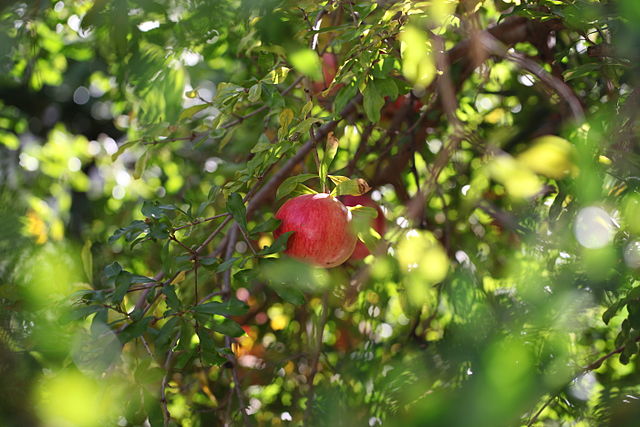Pomegranate
Punica granata
Family: Lythraceae | Place of Origin: Turkey to the Himalayas in Northern India
Origins and history:
Pomegranates originated in the region ranging from modern-day Turkey to northern India, the Mediterranean and the Middle East. The first recorded evidence of pomegranate cultivation comes from near the Tigris and Euphrates Valley in what is now Iraq, from around 2,200 B.C.E., though it was eaten and used by humans long before then. It is now primarily grown in India, Iran, Afghanistan, and Turkey as well as California and some parts of Arizona. There are about 100 different variations of pomegranate grown today, producing different colors and flavors of fruit and flowers.
The word “granata” in the scientific name of the plant was the inspiration for the name of the hand-held explosive. In the Middle Ages, shells filled with gunpowder granules were known as grenades due to their similar appearance to the seed-filled shell of a pomegranate, known as malum granatum at the time. There are references to pomegranates in the history and symbolism of various religions, including Christianity (alongside or held by the Virgin Mary), Judaism (as a symbol of righteousness), Buddhism (considered a blessed fruit alongside peaches and lemons), and Islam (mentioned three times in the Koran, representing the good things created by God). Eaten during the Iranian winter solstice celebration called Yalda Night, and as a part of Jewish Rosh Hashanah celebrations.

Identification characteristics
- Habit: Tree or shrub that can grow up to 5 meters tall (16.5 feet)
- Fruit: Fruit is a rounded hexagon shape and typically the size of a baseball, filled with hundreds of seeds surrounded by a fleshy, edible pulp called an aril. The fruit has a “crown” on top, left over from the flower.
- Flowers: The flowers are trumpet shaped, blooming in early summer to late fall, with thin, crepe-paper petals. They are usually coral red, yellow, orange, or pink.
Uses and preparation
The fruit and leaves were used to treat inflammation, cardiovascular disease, and especially gastrointestinal issues. The seeds are a good source of potassium and vitamin A,C, E, as well as various antioxidants, calcium, and iron.
Fruit: preserves (jams and jellies), wine, juice, cooking sauces, red dye. True Grenadine is made from pomegranate juice.
Leaves: used as a spinach replacement, made into tea (consumed for cold sores and mouth ulcers), and ground up as a salve for eczema.
Bark: consumed for stomach and gastrointestinal issues, treating tapeworm
Wood: decorative pieces and furniture